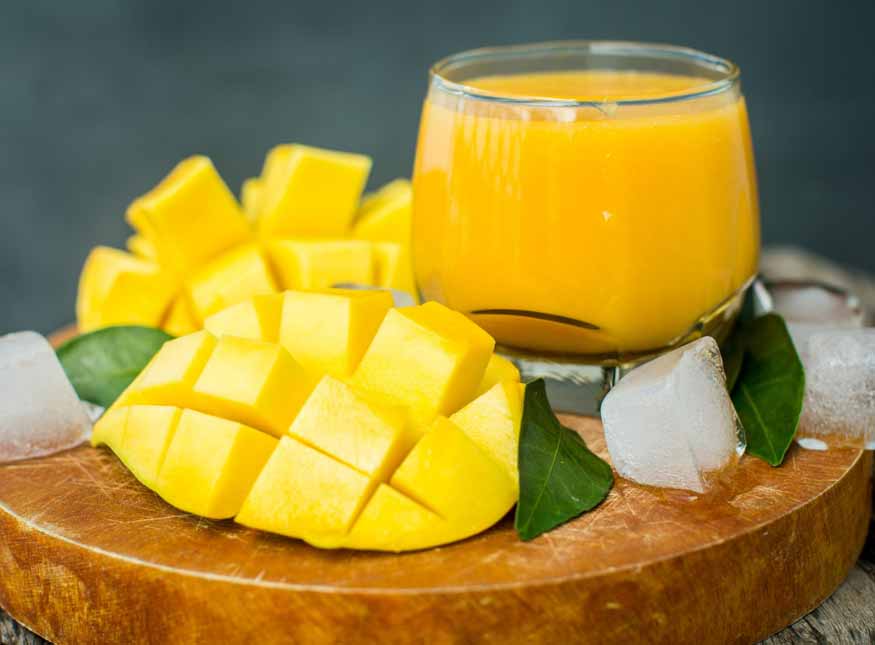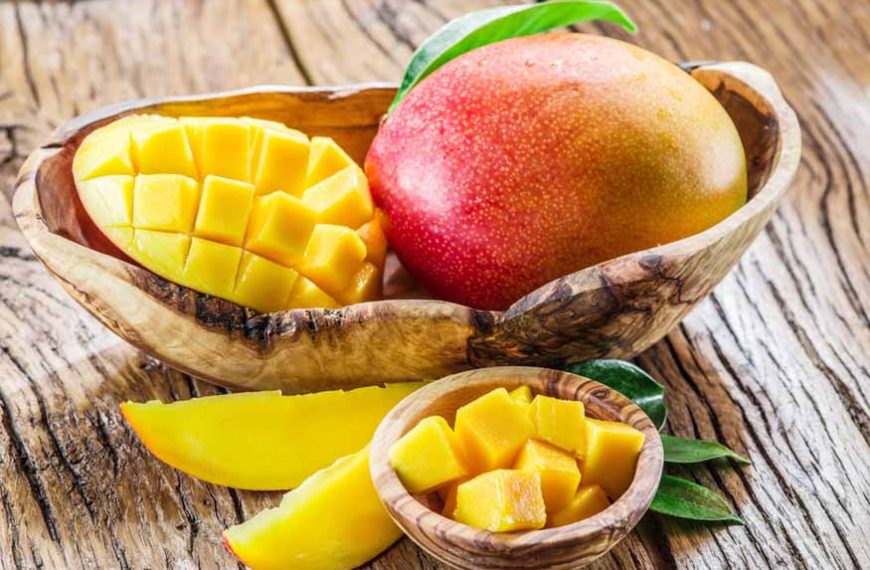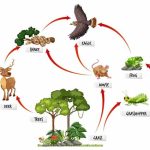It’s that time of the year again! When you’re flocking to the vendor to get the best possible price for those tasty, tropical ‘mangoes’. This time around, you might want to get some more for the baby! Mangoes can, after all, confer them with several wonderful benefits.
Can babies eat mangoes?
Mango is an excellent choice of fruit for babies, but only from 6 months of age when they are eating solid food. What you want to do is first start them off by having them eat them in pureed or mashed form. Once they are 9 months old, you might then consider giving them bite-sized mango pieces. In the case of baby-led weaning, you can even give them thinly sliced wedges without the peel, to hold and eat.
What is the nutritional value of a mango?
Mango is a healthy and nutritious fruit for babies. Packed with essential vitamins and minerals, it provides several benefits to their growing bodies. One of the key nutrients in mango is vitamin C, which helps boost the immune system, supports the formation of collagen, and keeps the skin, bones, and cartilage strong. Mango is also a good source of folate, a vital nutrient for brain development and DNA production, making it an excellent addition to a baby’s diet.
Before we get into the many wonderful benefits of eating mango for babies, here’s a look at all the nutrients this wonderful fruit is laced with.
One mango contains:
- Vitamin A – 210 mcg
- Protein- 0.5g
- Calories – 55
- Carbohydrates- 11.3g
- Folate- 90.43ug
- Vitamin B6- 0.1mg
- Vitamin C – 29.08mg
- Copper – 0.07mg
Types of Mangoes

Banganapalli
Banganapalli, commonly known as Safedi, is the oldest mango variety available in the market. It originated in the Andhra Pradesh town of Banaganapalle.
- Banganapalli mango season runs from April to June.
- Colour: Bright yellow
- Shape: oval-shaped
- Taste: somewhat sour.
- Other characteristics:
- Skin is edible.
- Mostly used to create preservatives.
- It weighs less than other mango kinds.
Payri
Mango Payri, like Banganapalli, symbolises the beginning of the mango season. This variety of mango thrives in Karnataka, Maharashtra, and Kerala.
- Season: April through June.
- Colour: Yellow with a reddish tint on the skin.
- Shape: oval-shaped
- Taste: Sweet with a distinct sour taste.
- Other characteristics:
- Used to prepare aamras.
- Quality doesn’t last long, so get them as soon as possible after purchasing them.
- Weighs 250-450 grams.
Kesar
The Kesar mango has a distinct smell that can freshen up your home. It is planted and cultivated in Gujarat’s Girnar mountains near Ahmedabad, and is named after the spice saffron.
- Season: June through July.
- Colour: The skin is dull yellow with a green tinge, while the internal pulp is saffron-coloured.
- Shape: roundish with a curving tip.
- Taste: sweet, but milder than Alphonso’s.
- Other characteristics:
- Mostly used for making aamras.
- Size ranges from small to medium.
- A little more pricey than other varieties of mangoes.
Mango Benefits for Baby
There are several wonderful health benefits of mango for kids. Here’s a look at some of the health benefits of Mango given below.
- Better Digestion
- Better Vision
- Boosts Immunity
- It can help cure Anaemia
- Good for the brain
If your baby is having mango, you can rest assured it will help them avail of benefits like better digestion, zero constipation, and a far lesser risk of developing acidity. This is one of the primary mango health benefits.
How: Mango is packed with fibre and digestive enzymes.
One of the greatest health benefits lies in its ability to prevent multiple problems related to the eyes, like dryness, itching, and even refractive errors. The more tangible benefit, of course, lies in its boosting vision. This is the other mango benefits for babies.
How: A small bowl of mango takes care of a fourth of the daily vitamin A requirement of your baby.
Move over, apple! A mango a day for kids goes a long way in boosting their immunity. All the more essential, as the immunity in children is inherently not as bad as it is in adults.
How: Mangoes are rich in vitamin C, besides being high in carotene and beta-carotene.
One of the greatest mango health benefits for kids is that it can prevent unwanted anaemia in children.
How: Mangoes are iron-dense. One mango contains 0.5mg of iron, which serves to boost the number of RBCs (red blood cells) in children.
Certainly one of the more important health benefits of mango is the fact that it ensures proper overall functioning of the brain, including better memory, too.
How: Mangoes contain an amino acid that is crucial for brain development namely, glutamine. They also contain Vitamin B6 in good quantities, a vitamin that, like glutamine, also helps improve the functioning of the brain.
Mango Recipes for Babies
While mango in itself is a fun food to eat for babies, you can get them even more interested in eating our wondrous national fruit, through these lip-smacking recipes.
Mango Shrikhand
A creamy Indian dessert that’s a hot favourite with adults – and babies, too!
Ingredients
- 500ml yoghourt
- Pulp from the variety of mangoes of your choice
- 2 tsp sugar
- 1 tsp elaichi (cardamom) powder
Method
Hang some tightly packed yoghourt in a thin cloth for 2-3 hours. You could even keep it overnight in the refrigerator till all the liquid drains out. You are left with around 400ml thick hung curd. Then, gently mix that hung curd with the mango pulp, sugar, and cardamom powder, and set it to chill.
Simple Mango Puree
Certainly the simplest mango recipe for your mango-loving baby!
Ingredients
- 1 ripe mango; peeled, its stone removed.
Method
Just add that mango to the blender and puree it to the consistency the baby is most fond of.
Tip: Alternatively, you can freeze some of that puree in an ice tray and serve it as a frozen dessert!
Mango Ice Popsicle
What’s more delightful than an ice-cold, homemade mango lolly on a sultry summer day? This treat takes that frozen iced tray puree above, to a new high!
Ingredients
- 1 cup yoghourt
- 1 ripe mango (chopped and peeled)
- 2 ripe peaches (chopped and peeled)
Method
Blend all the ingredients until you get a smooth, creamy mixture. Then, all you have to do is pour that delectable concoction into popsicle moulds and freeze them overnight.
Papaya Mango Smoothie
If you’re looking for a drink for your kids that’s packed with antioxidants, fibre, and folate, this one’s it!
Ingredients
- ½ cup papaya cubes
- ½ cup mango cubes
- ½ to 1 cup yoghourt
Method
Blend the above ingredients until you get a mixture that has a smooth consistency. Then, chill and serve!
Tip: If you’re looking to make a mango milkshake instead, drop the papaya and replace the yoghourt with half a cup of chilled milk.
Mango Rice Pudding
Let’s go tropical! Indeed one of the mango recipes for babies that culminates in spectacular dishes!
Ingredients
- 1 ripe mango (peeled and chopped)
- 2 cups coconut milk
- ¼ cup rice
- ½ mashed banana
- ½ tsp vanilla extract
Method
Bring a mixture of rice, coconut milk, and vanilla extract in a saucepan, to a boil. Allow it to simmer for around 25 minutes, stirring the mixture to prevent it sticking to the saucepan. If necessary, add more coconut milk. Add that chopped mango and cook until the rice is mushy. Then, allow it to cool before adding in the mashed banana. Serve warm or cool according to the baby’s preference, of course!
Make sure that you make the most of this sweet and luscious fruit, that only appears at this particular time of year. Most parents are mistakenly sceptical of feeding mangoes to their little children, even though it’s perfectly harmless. Let alone harmless; it’s one of those wonder foods for your children, and what’s more, versatile in its ability to be included in delicious recipes, as essayed here.
Enrol your child with EuroKids now and give them the right start, a flying start in their educational journey that they deserve.
For informative and accurate articles on all things related to your new born-toddler’s development, growth, health and nutrition, follow EuroKids Blogs and do check out our nationally recognized preschools – EuroKids for the first step in your kid’s educational journey!
















